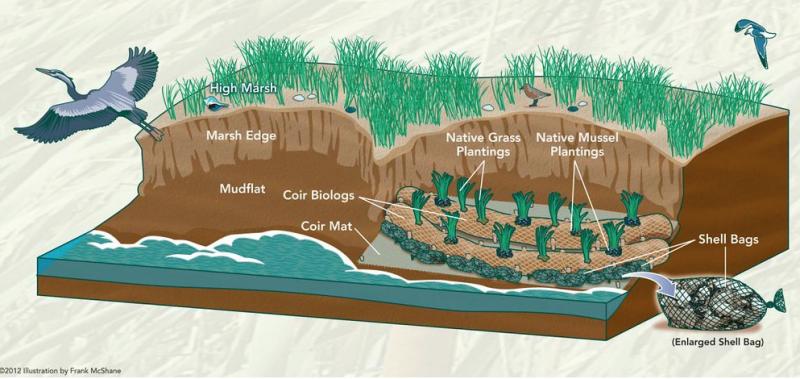Living shorelines are eco-friendly alternatives
The first phase of the Lewes Canal living shoreline project near Canalfront Park has turned out to be so successful, another phase has been added.
Officials gathered along the canal Aug. 5 in celebration of National Water Quality Month to highlight the second phase of the project completed in June by the Partnership for the Delaware Estuary, in conjunction with Delaware Department of Natural Resources and Environmental Control, U.S. Fish and Wildlife Service, and the Delaware Living Shorelines Committee.
DNREC Secretary Shawn Garvin said the first phase of the project was monitored by DNREC's Wetland Monitoring and Assessment Program with successful results. He said the project retained 80 square meters of shoreline while the area adjacent to the project lost 50 square meters of shoreline.
Benefits of living shorelines
A living shoreline is an alternative to hardened bulkheads and rip-rap that serves to stabilize and reinforce shorelines to protect them from erosion while improving water quality, and restoring and enhancing fish, wildlife and wetlands.
The new portion of protected shoreline is located adjacent to an already existing 180-foot section of living shoreline constructed in 2014 behind the Lewes Little League ball field.
“Living shorelines are an innovative and environmentally friendly alternative that uses natural materials such as oyster shells,” Garvin said. “This project is a good example of the benefits living shorelines provide: pollutant filtering to improve water quality; habitat for animals, fish and birds; and protection from erosion and of infrastructure; as well as aesthetics for property owners.”
The shoreline was constructed using natural materials, including coconut fiber coir logs and 1,300 bags of recycled oyster shells. A crew of 13 configured the oyster shell bags in long, wavy pyramid formations along the intertidal zone to reduce wave energy and allow wetland habitat restoration. The design includes breaks in the structure to allow tidal exchange, fish and fauna passage, and runoff outflow. This project will be monitored through a collaborative effort for several years to document increase of wetland size, and populations of ribbed mussels and oysters.
The oyster shells came from New Castle County restaurants through a Partnership for the Delaware Estuary recycling program.
Property access and shoreline coordination were provided by Lewes Historical Society and the Overfalls Foundation.
Libby Owen, Lewes Historical Society board of trustees chair, said the society was excited to be a partner in the project. “Normally, we deal with buildings and artifacts, and not often get a chance to work with living things. This project does pertain to our mission to help preserve this region,” she said.
Lewes Mayor Ted Becker said the project further enhances the resiliency of the shoreline, which is a high priority for city officials.
Officials said the project is a launching point for developing more partnerships and solutions to support coastal restoration, as well as promoting green infrastructure efforts of the Delaware Living Shorelines Committee.
Money for landowners
DNREC and the Sussex Conservation District offer landowners a 50 percent cost-share program up to $5,000 for living shoreline projects anywhere in Delaware.
For more information, go to delawarelivingshorelines.org.


























































